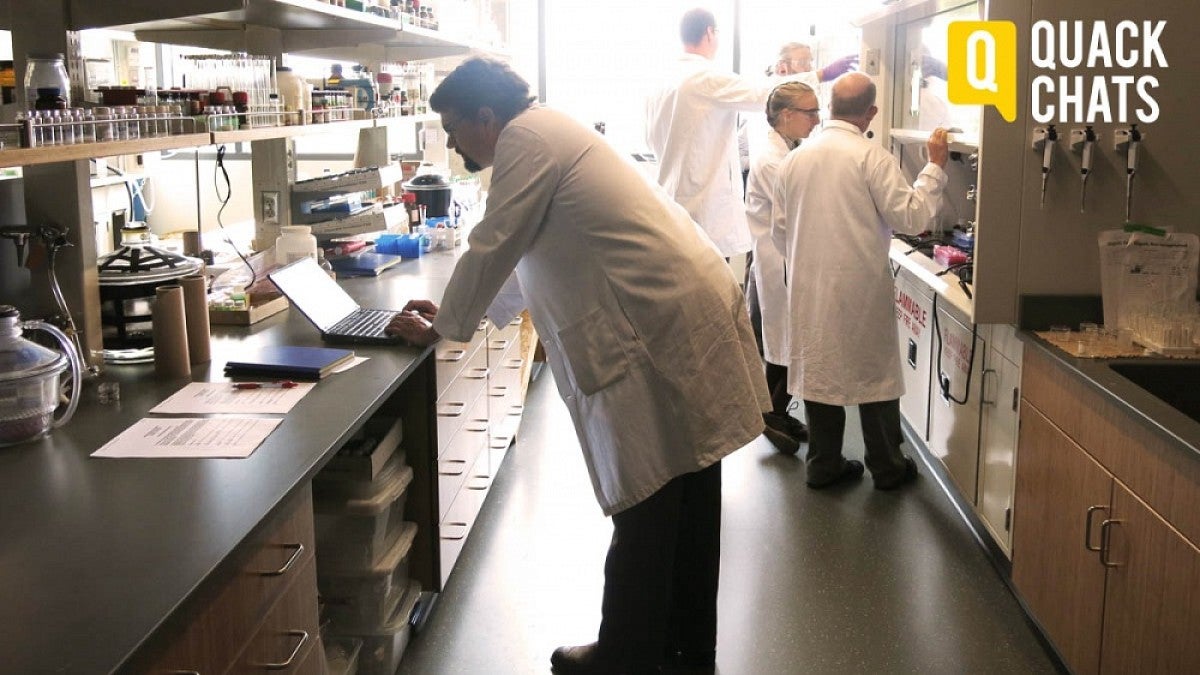Darren Johnson has a story tell about a very bad day in the chemistry lab that turned into a very good day.
It’s the story of SupraSensor Technologies — a company he helped create — and in telling that story at a Quack Chats pub talk, he will illuminate some of the ways in which scientists are learning to think more like entrepreneurs. The talk will be Oct. 25 at the Ax Billy Grill at the Downtown Athletic Club, 999 Willamette St., in downtown Eugene
“There are a number of environmental challenges facing society, and fundamental science can tackle those if you keep an eye to what the market needs and focus that fundamental science to fill those specific needs,” said Johnson, a professor in the Department of Chemistry and Biochemistry.
In his pub talk, Johnson will explore the research that led to the founding of SupraSensor and talk about some of the ways in which he and other scientists trained to think about the challenges they faced by looking at science through the lens of the market. The talk begins at 6 p.m. Admission is free. Food and drinks will be available for purchase.
That very bad day in the lab happened in 2011 when Calden Carroll, a doctoral student working with Johnson and UO chemistry professor Michael Haley, found something he wasn’t looking for.
The team was studying ways to tune the optical properties of molecules to respond to specific species of interest. Their hope was to create a molecular probe to visualize the movement of chloride through cells.
They had discovered a way to “turn on” a class of compounds when chloride was present, causing them to light up with a green, fluorescent light. Instead of activating the chloride like they planned, their experiment caused the nitrate to light up — a big setback for their project.
Or so it seemed.
What looked at first like a nonstarter turned out to offer a possible solution to a $2.4 billion problem, the overapplication of fertilizer by farmers. Nitrate is one of the primary components of fertilizer, and without a sensor to monitor nitrate levels in the soil farmers risk applying too much fertilizer to their crops to assure high yields.
The excess fertilizer washes off the fields and into nearby streams and rivers where it triggers algae blooms that deplete oxygen levels and create dead zones in the water where nothing can live.
The more Carroll learned about the agricultural market, the more the team realized the value of their discovery, and, thinking like an entrepreneur, Carroll pivoted, refocusing his attention, not on chloride sensors for biological imaging but on nitrate sensors for farming.
Johnson and his team got help becoming scientist-innovators with several critical trainings and funding programs. The National Science Foundation’s Innovation Corp program provided the funding to keep the research going and invaluable training on how to be more entrepreneurially minded. The team worked with entrepreneurs and educators to learn valuable lessons about scalability, how to appeal to customers and other key business concepts.
The SupraSensor team worked with UO’s Innovation Partnership Services office to patent their technology and received grants and other financial support from the NSF's Small Business Innovation Research/Small Business Technology Transfer Program, Oregon BEST and the Oregon Nanoscience and Microtechnologies Institute. In 2016, the company Climate Corporation bought SupraSensor. Carroll, Johnson’s former grad student, continues to work for the firm he founded today.
In his talk, Johnson will explain the importance of anions — problematic contaminants in the environment that cause human health and environmental problems — and examine some of the ways that the UO is training the scientists of tomorrow to have a competitive edge.
Johnson says the experience of creating and growing a company from the lab up changed the way he performs his research and the way in which he teaches and trains students. He’s involved in efforts to expand professional development opportunities for science students and continues to look for seed funding opportunities for fundamental science that’s tied to market opportunities.
“By understanding the market pull of our fundamental chemistry, we quickly built value in the team and not just the technology or company,” Johnson said. “The ability of Calden and his team to connect fundamental chemistry research to market awareness, specifically in agriculture, is a valuable skill that few chemists learn in school.”
—By Lewis Taylor, University Communications
Quack Chats, an outreach effort of University Communications, are designed to engage the public with UO researchers in an informal atmosphere. Another University Communications public outreach event, Run with a Researcher, happens at 9 a.m. Saturday, Oct. 28 to coincide with homecoming and the UO Innovation Summit. The event is free and open to the public. Participants should meet at the “O” desk on the lower level of the Erb Memorial Union. Four UO representatives — Dev Sinha, mathematics; Keith Frazee of educational methodology, policy and leadership, and enrollment management; Dyana Mason, public policy, planning and mangement; Charlie Butler, journalism; Richard Taylor, physics; Troy Campbell, business and marketing; and Marcus Langford, assistant dean of students for leadership and engagement — will lead participants on a 3.1-mile walk or 4.5-mile run. Paces are adjusted to participants’ abilities.


